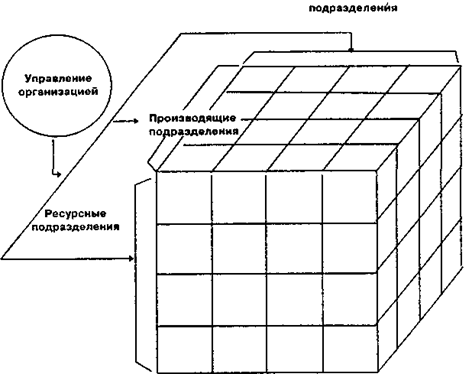home
 Management Management
 Management - Vikhanskiy OS Management - Vikhanskiy OS
|
Management - Vikhanskiy OS
4.2. Multidimensional organization
In the previous chapter, we considered a two-dimensional model of deparmentation or a matrix model for building an organization. Two dimensions in it were resources and results, with the orientation toward which the work is simultaneously combined in the form of matrix cells. The matrix organization itself is usually a combination of linear-functional and divisional organizations, as it were composed of them. However, with such an approach, the boundaries of the matrix organization remain such important variables as the territory, the market and the consumer, with the focus on which the work in the organization can also be combined. When this third dimension is added, multidimensional organizations appear. For the first time this term was used in 1974 by U. Goggin at. Description of the structure of the corporation "Dow Corning". A multidimensional organization can be depicted, as shown in Fig. 8.8.
The basis of a multidimensional organization is an autonomous working group that simultaneously performs three tasks:
• Ensuring production activities with the necessary resources;
• production for a particular consumer, market or territory of a product or service;
• maintenance of a specific consumer, development or penetration of a particular market, carrying out an operation within a certain territory.
On the totality of tasks performed, such autonomous groups usually receive the status of a profit center, and in some cases may be independent companies. However, in both cases they are somehow taxed by corporate taxes.

Fig. 8.8. Schematic diagram of the structure of a multidimensional organization
In a multidimensional organization, departments' budgets are developed by the departments themselves, the management of the organization only invests in them funds and lends money.
The problem of the matrix model, as mentioned earlier, is that it is based on a system of double subordination, which is its most vulnerable property. She is accused of creating a so-called organizational schizophrenia. A multidimensional model does not create such a problem. In a multidimensional organization, the relations of the members of the autonomous group with the leadership of the organization and its other divisions are no different from the relations with an outsider.
An example of a multidimensional organization may be the previously mentioned experimental "trolley" assembly teams at the Volvo plant. These brigades, consisting of highly skilled and versatile workers, receive an individual order from a particular person to assemble the car. The team itself determines what resources, from where and in what volume should be received. Next, the team collects the car on the "cart" from beginning to end and sells it to the customer. From the amount received, the team is calculated with suppliers, the company, employees and makes other payments, and the remaining amount is reinvested. The brigade is like an "enterprise in the enterprise". The main advantage of this approach is that it is possible to maximally satisfy the customer's demands by bringing it closer to the manufacturer. This experience is not yet of a massive nature due to its complexity and high cost. It requires a very high quality of employees, an adequate organizational culture, the perfection of operations and connections. In addition, an appropriate environment is needed: customers and suppliers, infrastructure, general culture and level of education and life.
Another scheme of the structure of a multidimensional organization is given in R. Akoff's book "Planning for a Future Corporation". It holds the idea that each division in a multidimensional organization can be organized in the same way as the organization as a whole. The multidimensional structure is applicable to any, up to the smallest, division of the organization. The smaller the unit or part of the organization, the less its staff and more diverse responsibilities for its manager. In an organization whose economic units are relatively independent, differ from each other and territorially scattered, a certain economic unit is made multidimensional, rather than the organization as a whole. This type of organization makes it possible for even a small unit to be as autonomous as possible in the structure of a larger organization. Thus, the multidimensional model creates, with the greatest possible degree of proximity, a free market within the organization, which does not exclude opportunities for synergy and economies of scale.
The main advantages of multidimensional organizations R. Akoff considers the following:
• There is no need for any reorganization in order to change the priority of the criteria used in the design of works. Accents can be changed by reallocating resources to the management of the organization;
• units can be created, eliminated or modified without major changes in the position of other units. The more parts of the organization are in contact with the "multidimensional" group, the less the changes in these parts affect it;
• creating the most favorable situation for the delegation of authority, while the role of the organization's leadership remains the leading one;
• a uniform, clearly fixed and easily measurable measure of efficiency is applied to each multidimensional entity - the resulting profit, which prevents the execution of pseudo work and the emergence of elements of a bad bureaucracy. At the same time, profit, considered as a necessary condition for business development, is not the only measure of success. The predominant goal is the development of a multidimensional organization and its members.


Comments
When commenting on, remember that the content and tone of your message can hurt the feelings of real people, show respect and tolerance to your interlocutors even if you do not share their opinion, your behavior in the conditions of freedom of expression and anonymity provided by the Internet, changes Not only virtual, but also the real world. All comments are hidden from the index, spam is controlled.